Submitted:
27 June 2023
Posted:
30 June 2023
You are already at the latest version
Abstract
Keywords:
1. Introduction
- 1.
- We establish the service route planning architecture of the power communication network, describe the service requests, service reachable routes, and network service carrying status (NSCS), and give the calculation of the NSCS parameters of the reachable route.
- 2.
- We carry out the problem planning of route allocation for a single service with the goal of reducing the variance of network risk and meeting the constraints of delay, bandwidth and RPSO, and propose a route planning scheme considering RPSO and RB.
- 3.
- We study the multi-service routing planning process with unifying the route assignment of non-relay protection service and the dual route assignment of relay protection service.
2. Route planning model of power communication network
2.1. Power communication network
2.2. Service request
2.3. Service reachable routes
2.4. NSCS parameters
2.5. NSCS parameters of the reachable route
2.5.1. Calculation of node service carrying parameter
2.5.2. Calculation of link service carrying parameters
3. The problem of single service route planning in power communication network
3.1. Power communication network risk balance
3.2. Constraints on route planning of relay protection services
3.3. Delay and bandwidth constraints for service route planning
3.4. Mathematical model of single-service route planning problem
4. Single-service route planning scheme based on RPSO-RB
4.1. Reachable route collection based on KSP algorithm
4.2. RPSO-RB route planning scheme
5. Multi-service route planning implementation policy
5.1. Update NSCS parameters for multi-service routing planning
5.2. Multi-service routes planning process
5.3. Service blocking rate
6. Simulation Results
6.1. Simulation parameter setting
6.1.1. Communication network parameters
6.1.2. Service request parameter
6.2. Research on the performance of service route planning policy
6.2.1. Impact of RPSO threshold on solution performance
6.2.2. Impact of the value of k on the solution performance
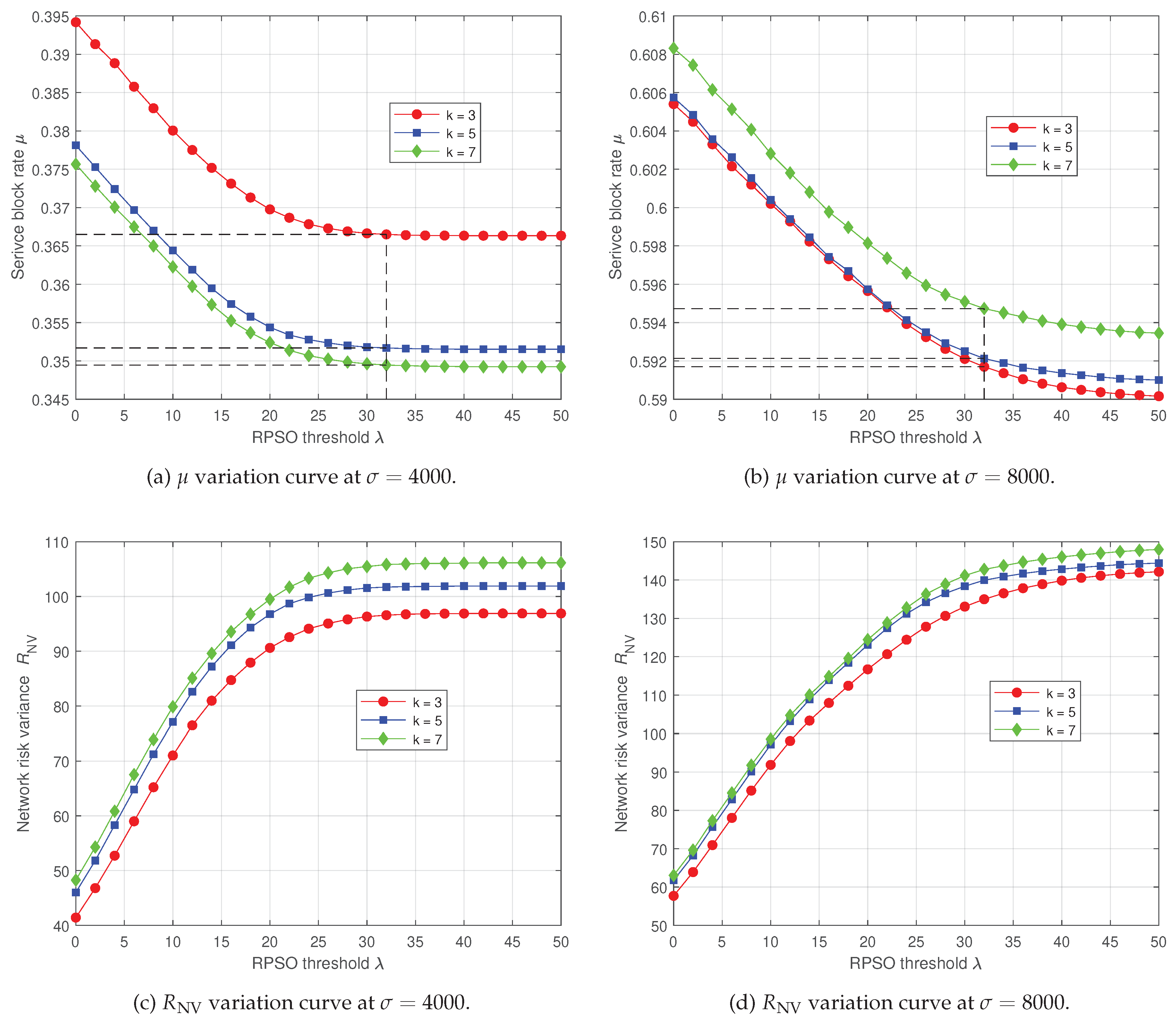
6.3. Comparison of route planning schemes
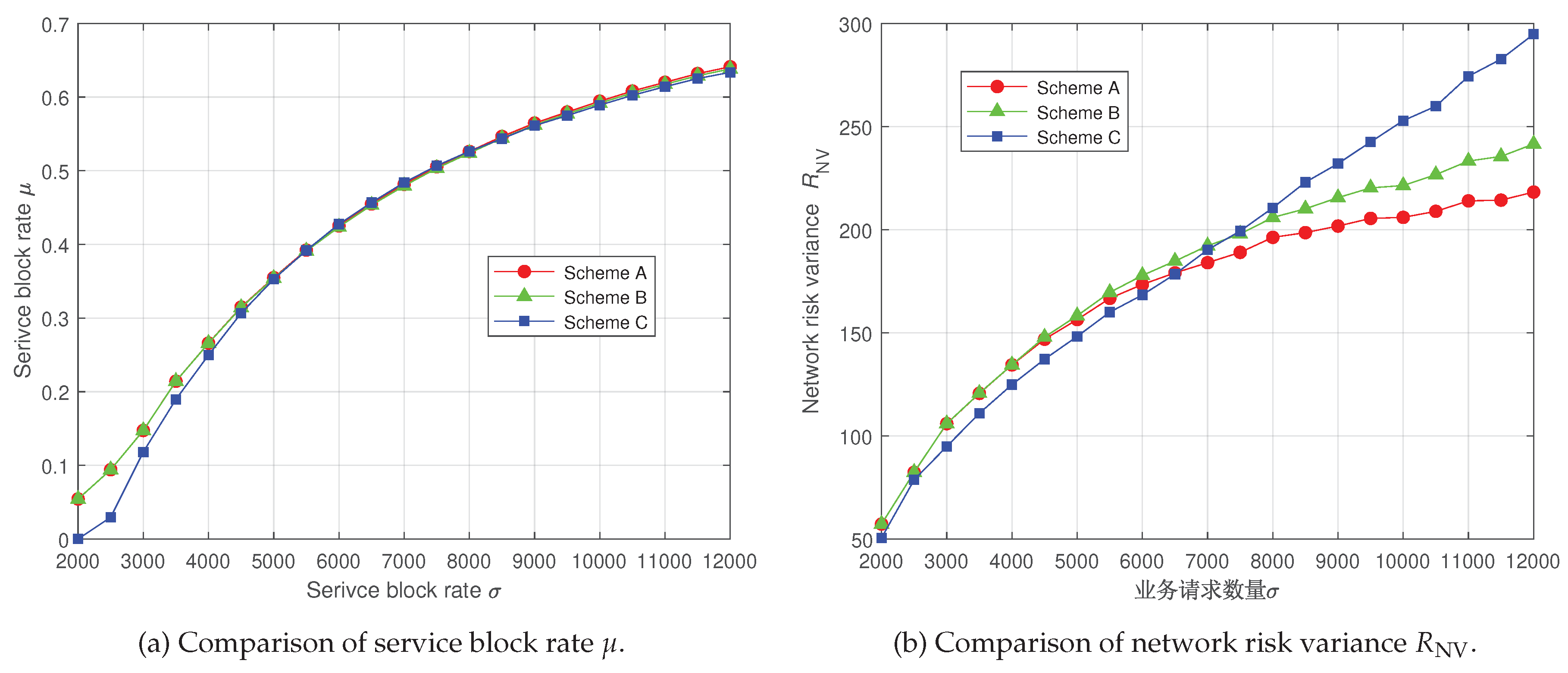
7. Conclusions
Acknowledgments
References
- J. Sanusi, O. Oghenewvogaga, B. B Adetokun, A. M Abba, The impact of communication technologies on the smart grid, 2022 IEEE Nigeria 4th International Conference on Disruptive Technologies for Sustainable Development (NIGERCON) (2022) 1-5. [CrossRef]
- F. E. Abrahamsen, Y. Ai, M. Cheffena, Communication technologies for smart grid: A Comprehensive Survey, Sensors 21 (23) (2021) 8087. [CrossRef]
- P. Y Kong, Optimal configuration of interdependence between communication network and power grid, IEEE Transactions on Industrial Informatics 15 (7) (2019) 4054-4065. [CrossRef]
- Z. Min, W. Muqing, Q. Lilin, A. Quanbiao, L. Sixu, Evaluation of cross-Layer network vulnerability of power communication network based on multi-dimensional and multi-layer node importance analysis, IEEE Access 10 (2022) 67181-67197. [CrossRef]
- D. Said, A survey on information communication technologies in modern demand-side management for smart grids: challenges, solutions, and opportunities, IEEE Engineering Management Review 51 (1) (2023) 76-107. [CrossRef]
- S. Aggarwal, N. Kumar, S. Tanwar, M. Alazab, A survey on energy trading in the smart grid: taxonomy, research challenges and solutions, IEEE Access 9 (2021) 116231-116253. [CrossRef]
- P. Y Kong, Routing in communication networks With interdependent power grid, IEEE/ACM Transactions on Networking 28 (4) (2020) 1899-1911. [CrossRef]
- W. Yao, Q. Chen, J. She, J. Chen, X. Zhuo, J. Li, Method for calculating the link importance of power communication network based on link availability, 2019 IEEE 3rd Advanced Information Management, Communicates, Electronic and Automation Control Conference (IMCEC) (2019) 136-139. [CrossRef]
- Y. Guo, M. Xu, Research on reliability evaluation model and path optimization for power communication network, 2015 5th International Conference on Electric Utility Deregulation and Restructuring and Power Technologies (DRPT) (2015) 2495-2500. [CrossRef]
- Z. Shao, Y. Wang, X. Chen, Y. Zhang, J. He, Z. Wang, A network risk assessment methodology for power communication business, 2016 IEEE International Conference on Network Infrastructure and Digital Content (IC-NIDC) (2016) 40-43. [CrossRef]
- Y. Huang, X. Shen, Y. Xiao, M. Sun, H. Liao and W. Yuan, Research on risk assessment algorithm for power monitoring global network based on link importance and genetic algorithm, 2022 International Conference on Knowledge Engineering and Communication Systems (ICKES) (2022) 1-8. [CrossRef]
- O. Dong, P. Yu, H. Liu, L. Feng, W. Li, F. Chen, L. Shi, A service routing reconstruction approach in cyber-physical power system based on risk balance, NOMS 2018 - 2018 IEEE/IFIP Network Operations and Management Symposium (2018) 1-6. [CrossRef]
- B. Ti, J. Wang, G. Li, M. Zhou, Operational risk-averse routing optimization for cyber-physical power systems, CSEE Journal of Power and Energy Systems 8 (3) (2022) 801-811. [CrossRef]
- B. Liu, P. Yu, X. Qiu, L. Shi, Risk-aware service routes planning for system protection communication networks of software-defined networking in energy Internet, IEEE Access 8 (2020) 91005-91019. [CrossRef]
- M. Luo, X. Hou, J. Yang, Surface Optimal Path Planning Using an Extended Dijkstra Algorithm, IEEE Access 8 (2020) 147827-147838. [CrossRef]
- B. Chen, X. Chen, H. Chen, W. H K Lam, A fast algorithm for finding K shortest paths using generalized spur path reuse technique, Transactions in GIS 25 (2021) 516-533. [CrossRef]
- P. Zhao, P. Yu, C. Ji, L. Feng, W. Li, A routing optimization method based on risk prediction for communication services in smart grid, 2016 12th International Conference on Network and Service Management (CNSM) (2016) 377-382. [CrossRef]
- N. Xing, S. Xu, S. Zhang, S. Guo, Load balancing-based routing optimization mechanism for power communication networks, China Communications 13 (8) (2016) 169-176. [CrossRef]
- J. Lv, Y. Liu, K. Gao, J. Wang, X. Guo, X. Yu, Y. Zhao, J. Zhang, Service awareness recovery under N-1 failure in power grid optical communication networks, 2021 IEEE 4th International Conference on Automation, Electronics and Electrical Engineering (AUTEEE) (2021) 303-306. [CrossRef]
- N. Ngamjaroen, P. Rapisak, Communication service risk evaluation based on risk balancing network for selecting service route, 2021 International Conference on Power, Energy and Innovations (ICPEI) (2021) 171-174. [CrossRef]
- B. Li, C. Lu, B. Qi, Y. Sun, D. Li, S. Chen, B. Yang, P-cycle based protection scheme with cycle multiplexing and capacity balance for multicast service in substation communication network, International Journal of Electrical Power & Energy Systems 102 (2018) 340-348. [CrossRef]
- B. Qi, L. Liu, B. Li, S. Liu, X. Wu, C. Lu, C. Zhu, An emerging survivability technology for dispatching service of electric power communication network, IEEE Access 6 (2018) 21231-21241. [CrossRef]
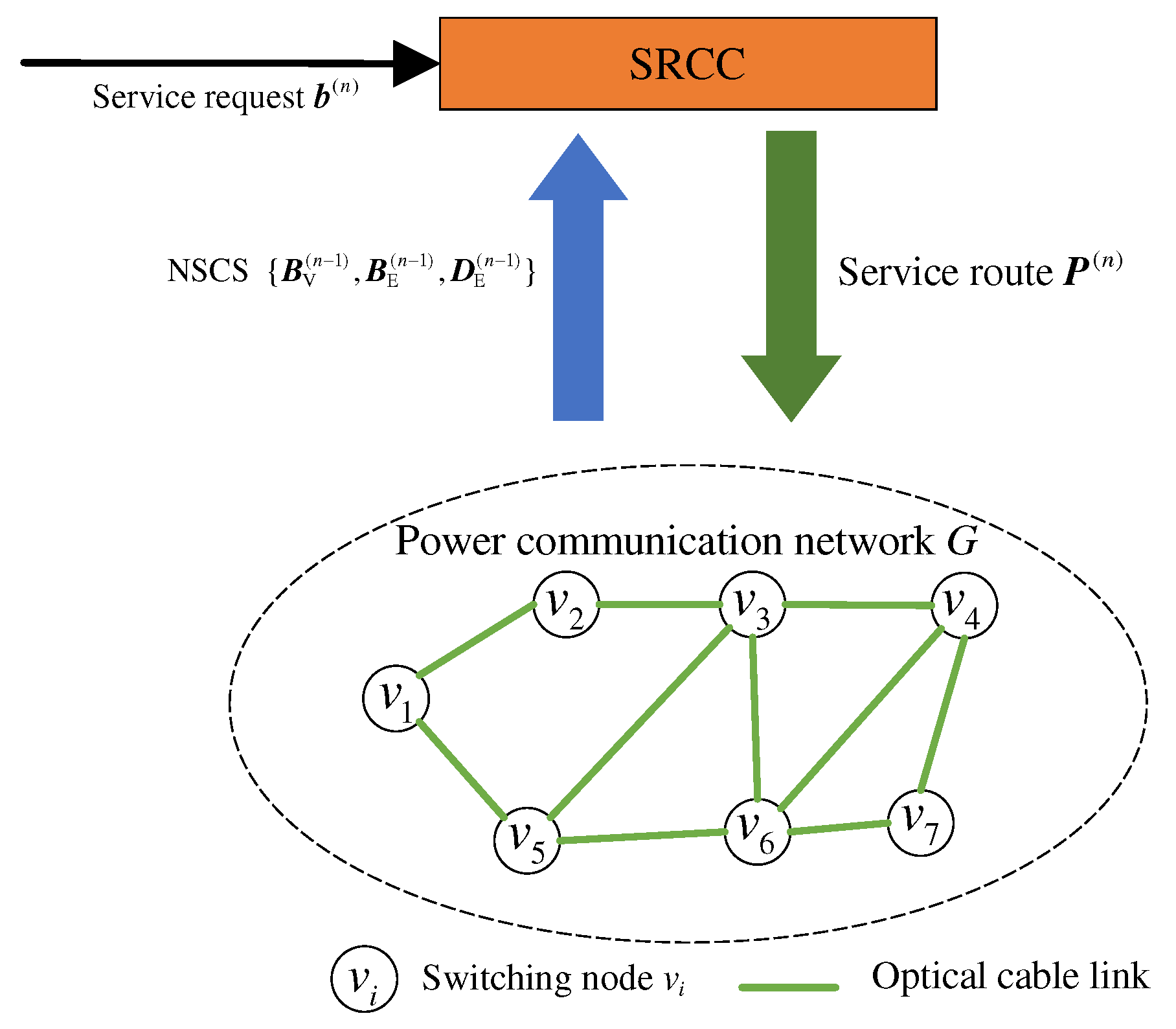
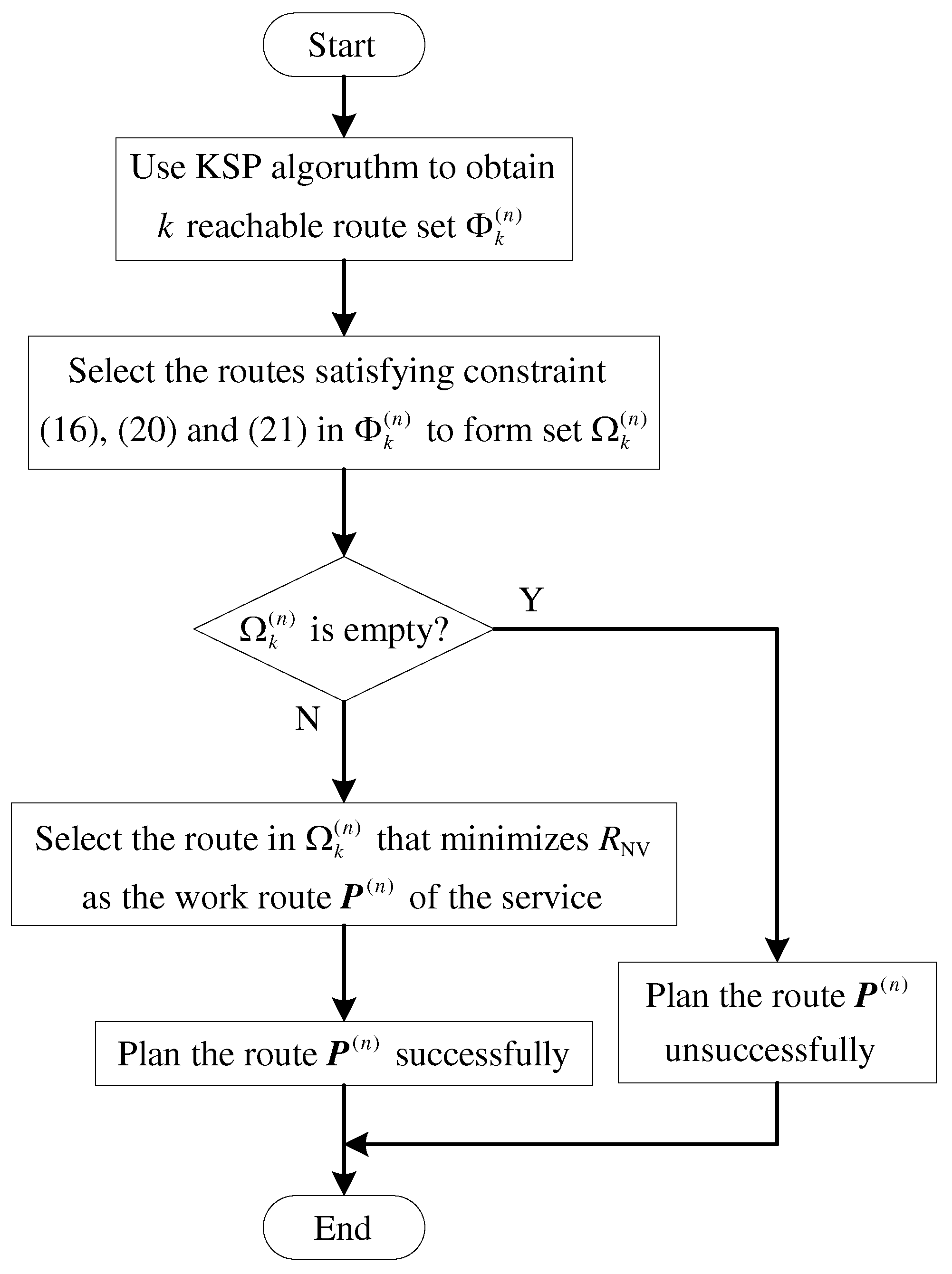
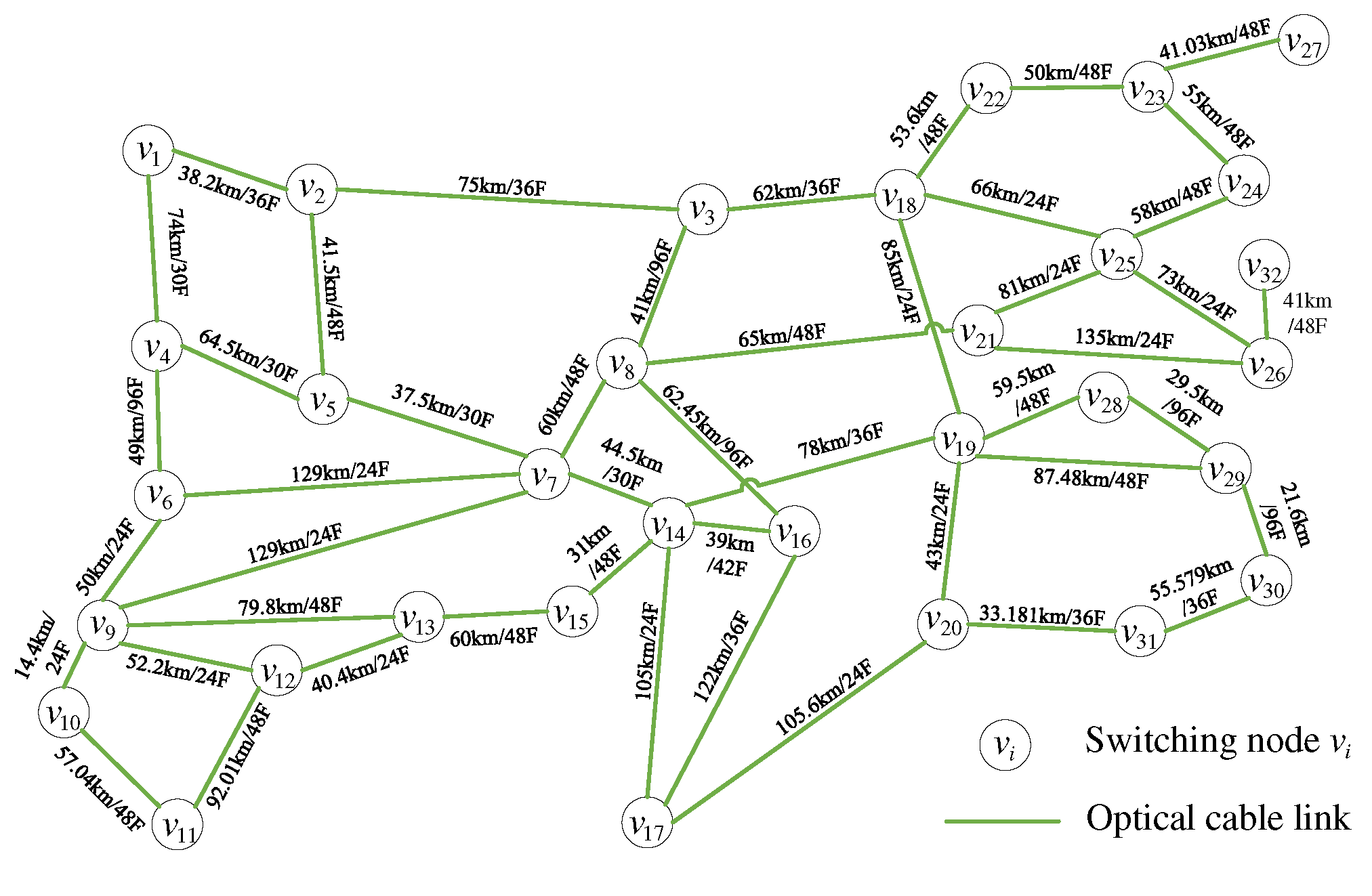
| Service types | Maximum delay/ms |
Bandwidth /(Mbits/s) |
Service importance |
Service quantity ratio |
|---|---|---|---|---|
| Relay protection service |
12 | 2 | 0.9981 | 5 |
| Stably controls system service |
30 | 2 | 06069 | 10 |
| Schedule automation service |
100 | 2 | 0.1008 | 20 |
| Communication monitoring service |
500 | 2 | 0.0768 | 15 |
| Management telephone service |
5000 | 0.5 | 0.0652 | 30 |
| Information support system service |
5000 | 10 | 0.0234 | 20 |
Disclaimer/Publisher’s Note: The statements, opinions and data contained in all publications are solely those of the individual author(s) and contributor(s) and not of MDPI and/or the editor(s). MDPI and/or the editor(s) disclaim responsibility for any injury to people or property resulting from any ideas, methods, instructions or products referred to in the content. |
© 2020 by the authors. Licensee MDPI, Basel, Switzerland. This article is an open access article distributed under the terms and conditions of the Creative Commons Attribution (CC BY) license (https://creativecommons.org/licenses/by/4.0/).




